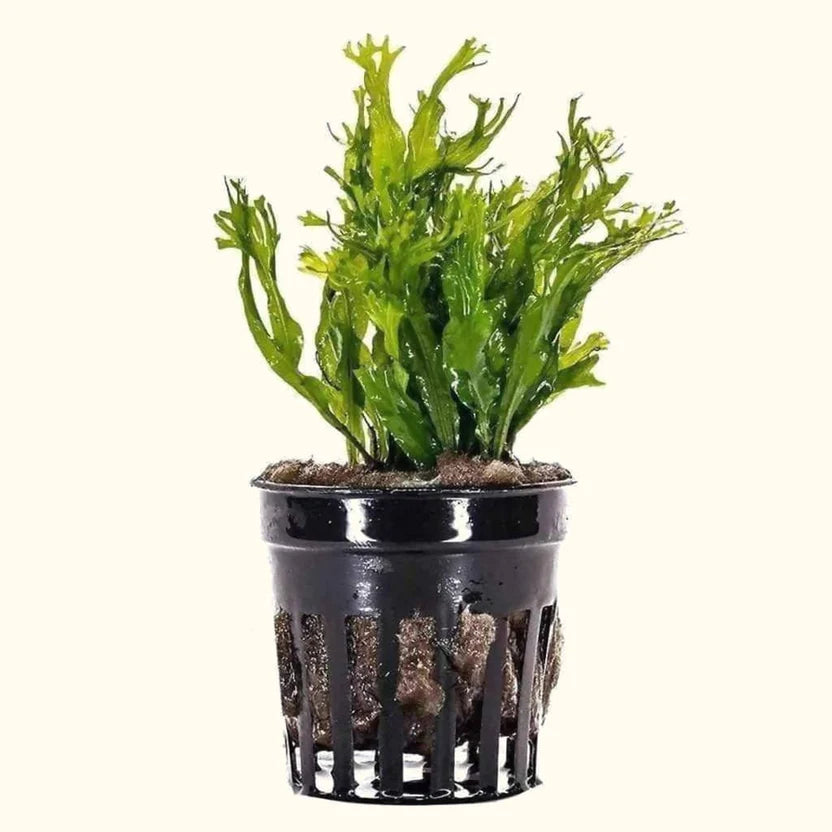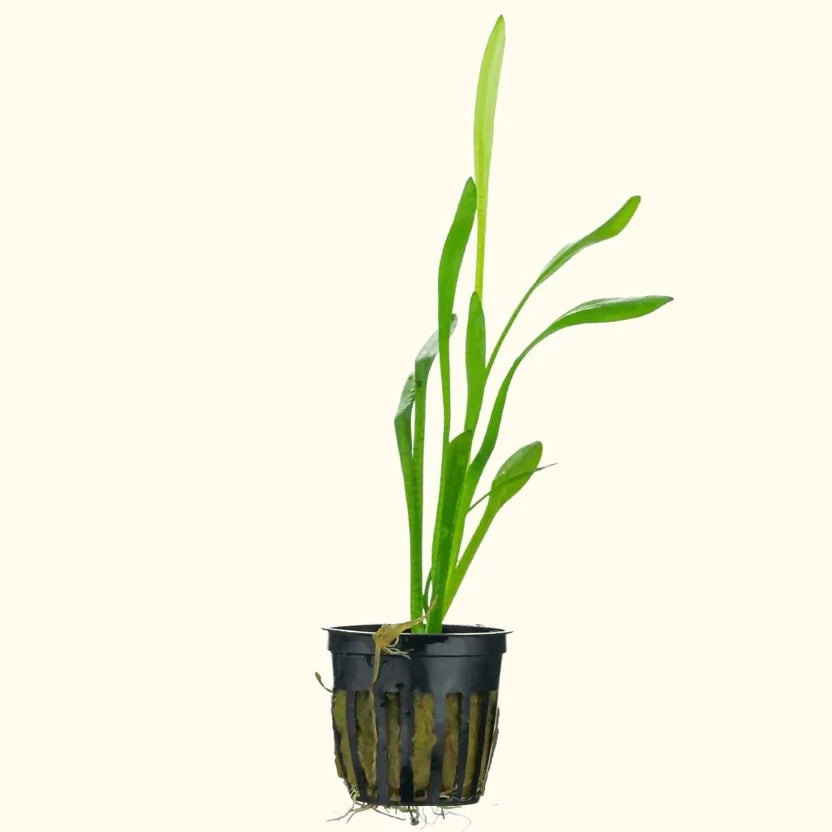Top 10 Easy Aquarium Plants for Beginners
Planted aquariums are very popular nowadays because of their natural beauty and amazing ability to consume the toxic nitrogen compounds produced by fish waste. However, many beginners excitedly try and then fail to keep their green foliage from turning brown. After more than a decade of keeping, propagating, and now selling aquarium plants, we’ve thoroughly vetted out our list of top 10 easy aquarium plants that can stand up to a beating and won’t break the bank.
1. Marimo Moss Ball

Known as the world’s easiest aquarium “plant,” this marimo moss ball is neither a moss nor plant but rather a naturally occurring ball of cladophora algae. Its main care requirement is to lightly roll the marimo ball in your hands every time you do a water change so that it maintains its round shape and all parts of the algae get access to light. They’re quite inexpensive and unique looking, so people often buy an army of them to fill their betta tanks or goldfish aquariums. You can even unroll them and wrap them around driftwood to create a miniature tree. For more information, read our complete care guide here.
2. Amazon Sword

This classic aquarium plant is known for its ability to grow huge and take over your fish tank with luscious greenery. Lighting and substate are not as important as making sure it gets fed lots and lots of root tabs. When you first buy it, the sword usually has big, round leaves that are emersed grown (or grown outside of water). Once placed in water, these large leaves melt back as the plant reabsorbs their nutrients to make longer, narrower leaves that are submersed grown (or grown underwater).
If these new leaves appear to be yellowing, make sure to give it more root tabs. Eventually, the sword may grow big enough to become a mother plant, creating long spikes that turn into baby sword plants for you to plant in other aquariums.
3. Cryptocoryne wendtii

This low-maintenance crypt is one of our favorites because it doesn’t require liquid fertilizers or carbon dioxide (CO2) injection. This slow-growing plant does well under almost any light and in almost any substrate. It does prefer to feed from its roots, so if you use an inert substrate that doesn’t have many nutrients, make sure to regularly add root tabs every three months or so for optimal health. Crypt wendtii comes in many varieties, such as green, brown, tropica, and red. To better enhance the redness of its leaves, consider dosing extra iron supplements to the aquarium water.
Much like Amazon swords, crypts leaves are known for melting back when they’re first added to a new tank. If you see this happen, don’t throw away your “dead” plant! Leave it planted in the substrate, and once it has adjusted to your water chemistry, it'll quickly rebound and grow new leaves.
4. Aponogeton crispus

This low light plant grows from a bulb and creates long, wavy-edged leaves that flow beautifully in an aquarium. In fact, this is one of the main species sold as a “betta bulb” at chain pet stores because they’re so easy to care for. Just place the bulb on top of the substrate, and watch it rapidly sprout leaves and roots. Sometimes it goes through a dormant period where, for a couple of months, the larger leaves die back. Just leave the plant in the aquarium, and new growth will once again emerge. For only a few dollars, try out this great-looking plant that grows very fast, gets fairly tall, and can even produce flowers for you.
5. Bacopa caroliniana

If you’re interested in trying stem plants, bacopa is a good beginner option to start with. This native from the southern United States has a straight, vertical stem with small, roundish leaves. It doesn’t require CO2 injection, but it does enjoy liquid fertilizers like Easy Green. While it can grow in low light, the leaf tips turn coppery-red in the presence of high light and iron dosing.
As with most aquarium plants, bacopa is usually grown out of water at plant farms. Once you plant it underwater, the top of the plant starts producing submerse-grown leaves, while the emersed-grown leaves down below begin to die off. Eventually, the bottom half of the stem looks like a bare, skinny trunk, so just snip off the tops and replant them for a fuller-looking plant. That’s also how you propagate bacopa – as the plant grows taller and taller, just cut off the tops and plant them in a new location.
6. Christmas Moss

If you’re setting up a breeding tank, get yourself some Christmas moss! Their fluffy fronds look like little Christmas trees and provide excellent cover for baby fish and shrimp. Aquascapers often tie them to rocks and driftwood in order to imitate the look of an overgrown, moss-covered forest. In order to keep this slow-growing moss looking its best, invest in small algae eaters like amano shrimp and dose some liquid fertilizer to boost its growth.
7. Vallisneria

Want to make your aquarium look like an underwater jungle with very little effort? All you need is one plant – vallisneria. When given plenty of root tabs and liquid fertilizers, this tall, grass-like species grows all the way to the top of water surface and readily spreads by making side shoots in the substrate. Once it’s well-established in your aquarium, you can even add fish that are traditionally known for digging up or eating plants (such as goldfish or African cichlids). See our care sheet on vallisneria here.
8. Java Fern

Both java moss and java fern get their names from the Indonesian island of Java, and while both are very easy to care for, they are quite different in appearance. There are several varieties of java fern – such as narrow leaf, Windelov (or lace), and trident – but the most popular type has long, pointed leaves with deeply ridged veins. All of its leaves and roots sprout from the rhizome (a thick, horizontal stem or stalk), so make sure not to plant the rhizome into the substrate. Instead, most people wedge the plant into the crevices of rocks and wood, and the roots eventually grow tightly around it. You can also use sewing thread or super glue gel to make sure the plant stays in place, so follow this article for step-by-step instructions.

Windelov java fern
Since the roots do not need to be planted into substrate, it mostly absorbs nutrients from liquid fertilizers in the water column. You can propagate it either by cutting the rhizome in two or by letting one of the leaves float at the surface. Soon the rows of black spots (known as sporangia) on the leaf will develop into baby plantlets with their own tiny leaves and roots. These plantlets can eventually be detached and planted elsewhere in the aquarium. Read our full java fern care guide here.
9. Cryptocoryne lutea

Cryptocorynes are so undemanding and beginner-friendly that we had to add another one to our list. Unlike crypt wendtii, this species has slender, green leaves that add variety in texture to your aquarium. Like most crypts, you can use almost any substrate and any light to make them happy, and no CO2 injection is needed. In general, crypts grow slowly, but give it three months from the day you put them in your aquarium and it’ll soon become one of your favorites. Faster-growing plants often require frequent pruning, whereas crypts look great for a very long time without any special maintenance besides the occasional root tab. For more details, check out our dedicated article on them here.
10. Dwarf Sagittaria

Need an easy carpeting plant to complete your aquascape? Dwarf sagittaria is a hardy, grass-like plant that looks like a miniature vallisneria. If you use high light, it stays short and small, but if you use low light, it grows pretty tall to get closer to the light. As for nutrients, it appreciates both root tabs and liquid fertilizers in the water column. Dwarf sag propagates readily by send out runners throughout the substrate. If it spreads to an unwanted area of the tank, just pull out the new shoots and replant them elsewhere.
Fill your tank with this curated collection of beginner-friendly plants, and you’ll have the best chance of success for your new planted aquarium. If you’re not seeing healthy growth for some reason, check out our free guide to plant nutrient deficiencies to troubleshoot the issue.




